The first time I went to a video game concert, I lost my grip on reality.
I walked into the Long Center for the Performing Arts one boiling summer evening in Austin, Texas, and plunged into an alternate dimension caught somewhere between the American Southwest and the Kingdom of Hyrule. Cosplay Princess Zeldas snapped selfies in the foyer. Middle-aged Heroes of Time perused merchandise tables on the expensive carpet. Toddlers waddled around in Kokiri gear, pre-teens whacked each other with plastic Master Swords, and two Ganondorfs chomped on Tex-Mex in the corner. Marooned in the crowd wearing a low-key Triforce t-shirt, I couldn’t decide if I was the only sane or completely crazy person there.
Ten minutes to the hour, the living cosplay chaos swirled into the dark auditorium. A giant projector screen glowed in front of us, and on a stage in front of that, a symphony orchestra sat quietly, almost invisible. Silence. Lights. Applause. The screen exploded into life. Scenes from every Legend of Zelda game in the past two-and-a-half decades flashed in front of our faces. The orchestra spun out the live soundtrack to every clip. Pianos sang, violins wept, and trumpets stormed the Song of Healing from Majora’s Mask, the battle score from Twilight Princess, the title theme from Breath of the Wild. It was mesmerizing.

A snapshot of The Symphony of the Goddesses. Ask yourself: who’s conducting the show?
It was also supremely disorienting. What was real, and what was video game? Sitting there in my lame t-shirt, I plunged in and out of observation and memory—concert hall and living room, projector and TV screen—reliving my favorite game sequences in concert with the multimedia phantasmagory. My thumbs jerked every time video-Link swung the Master Sword. My head swung between the screen in front of me to the seats beside me; Link and Zelda were everywhere I looked, saving Hyrule with swords and thumbs. The pixels seemed to dance from the screen, float across the orchestra, and—as if by magic—rearrange themselves into the cosplay-donning people to my left and right.
I managed to hold it together for nearly an hour of reality-blurring gyrotechnics—easily 80% of the show—until the sound of ocean waves crashed through the loudspeakers. A shot of Outset Island from The Legend of Zelda: Wind Waker rolled onto the projector screen. A pluck of strings, a shuddering breath, and the lead flute soared into the Wind Waker title theme. And suddenly, the auditorium disappeared.
I was back in a white-carpeted living room, eight years old, saving Hyrule with my sister. It’s Saturday afternoon, and the sun is shining. It smells like the sea. I’m wearing a paint-splattered t-shirt—never heard of business casual in my life—and Link is wearing his blue scorpion shirt—never heard of the green Hero of Time getup in his life. I’m not worried about the SAT, term papers, or what I’m going to do when I grow up. I’m not even worried about prophecies, Triforce shards, or arch-baddie Ganondorf. All that matters is hacking grass for rupees and mastering the jump-attack. My sister’s laughing on the floor beside me, and Link’s sister hasn’t been kidnapped by any monstrous birds. The scariest thing any of us has seen is the snot-sucking kid who runs around Outset Island without wiping his nose.

A shot to make Ken Burns proud.
Just as suddenly, the music ended, and I was back in the auditorium, surrounded by strangers in tights. What was left of reality rushed in at me again. And I kid you not, I started to cry.
What on earth—on any earth—happened to me? One moment I was sitting in a concert hall, the next I was swimming in a multimedia memory. The Links, Zeldas, and Ganondorfs stationed around me never whipped out tissues, but they were stirring, clapping, smiling, gasping, and sniffling loudly enough to make me suspect they were just as powerfully affected by the musical display. What was going on?

What I probably looked like waking up from my Wind-Waker-induced time warp.
The answer takes us back to a 4,215-page novel published in 1913. In it, one of the sages of twentieth-century literature explores why The Symphony of the Goddesses held me and countless other gamers spellbound in our seats—approximately one hundred years before it happened.

Link demonstrates how literature holds the answers to life’s most important puzzles. English teachers around the world rejoice!
The Phenomenology of Cookies and Video Games
Marcel Proust is perhaps the most famous novelist in French literary history. The seven-volume epic novel, In Search of Lost Time, is his most famous work. An episode near the beginning of the first volume, when the narrator takes a bite of a French cookie, is the most famous passage in the 1.2-million-word book. See if the excerpt below conjures up any recollection of my Zelda concert reality-trip:
“No sooner had the warm liquid mixed with the crumbs touched my palate than a shiver ran through me and I stopped, intent upon the extraordinary thing that was happening to me. An exquisite pleasure had invaded my senses, something isolated, detached, with no suggestion of its origin… And suddenly the memory revealed itself. The taste was that of the little piece of madeleine which on Sunday mornings at Combray…my aunt Léonie used to give me, dipping it first in her own cup of tea of tisane. The sight of the little madeleine had recalled nothing to my mind before I tasted it…But when from a long-distant past nothing subsists, after the people are dead, after the things are broken and scattered, taste and smell alone, more fragile but more enduring, more immaterial, more persistent, more faithful, remain poised a long time, like souls, remembering, waiting, hoping, amid the ruins of all the rest; and bear unflinchingly, in the tiny and almost impalpable drop of their essence, the vast structure of recollection.”[1]
This passage is typically referred to as “the episode of the madeleine.” Proust’s narrator nibbles an innocent-looking sweet cake, and the taste shoots him back into childhood. Involuntary memories spill out of his subconscious, and he gets sucked away under waves of nostalgia.
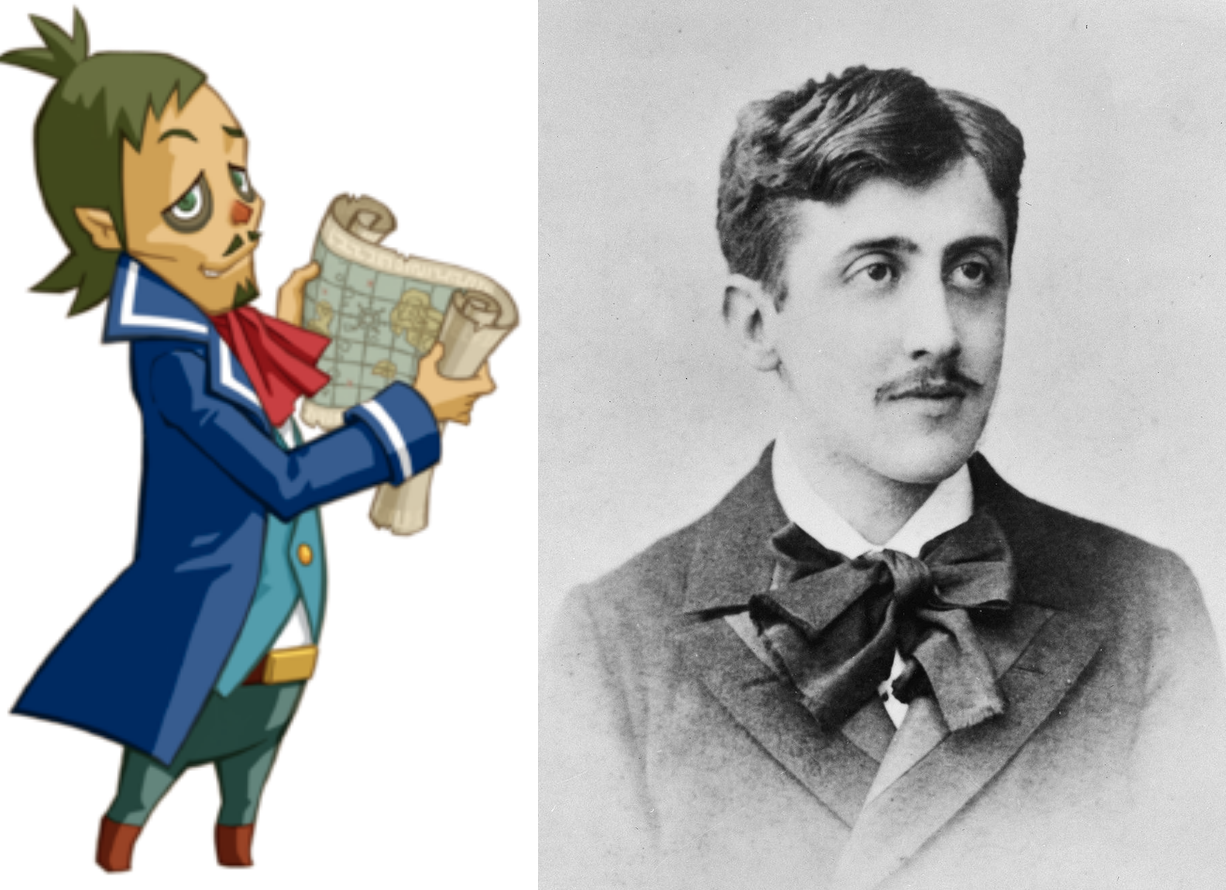
Proust in the late 1800s, anticipating The Legend of Zelda in both theories and looks. Linebeck vs. the literary legend—who wore the pencil mustache better?
Modern psychologists have thoroughly researched the phenomenon that Proust describes. The scholarly consensus is largely intuitive: sense inputs trigger autobiographical memories. Tastes, sights, smells, and sounds whip us back into past experiences connected with those sensations. The flashback is automatic and vivid. Anyone who’s felt time-warped to middle school by the throwback radio can relate.
In honor of the prescient Proust, this phenomenon is called the “the madeleine effect.” Its logic is simple: a sense input sends us back to a moment in time when we felt that same sense input. Simple as a cup of tea.
The cosplay Hylians and I experienced a madeleine effect, of sorts, at The Symphony of the Goddesses. The auditory inputs from the orchestra and the visual inputs from the projector screen yanked us back into our experiences playing the Zelda games we were hearing and watching. Our thumbs twitched, and our eyes glistened. At the opening notes of the Wind Waker title theme, I started thinking about Saturday afternoons with my sister, joysticking around Outset Island in a living room much less fashionable than the one Proust was envisioning at Combray.

Link having his own Proustian moment in search of lost memories in Breath of the Wild.
But even as a helpful framing device, In Search of Lost Time has limited explanatory power when it comes to my Zelda-triggered time-trip in the dark auditorium. Proust deals with stories in 2D texts; we’re dealing with interactive games in 3D graphics (at least since Ocarina of Time). And when we move from cookies to video games, the madeleine effect gets much more interesting.
Three disclaimers before we get into the specifics.
- First, we might trace this phenomenon along any number of sense-inputs, but I’ll stick with game music because of my inordinate emotional attachment to the Legend of Zelda soundtracks.
- Second, my analysis of this phenomenon is subjective. The madeleine effect wrestles with phenomenology—what it feels like to experience a time-tripping sense input—and since Proust never wrote about video games, and no psychological study that I’m aware of has studied music-evoked autobiographical memories in video games, I’m arguing from firsthand experience.
- Last, and following from the first two, I focus this analysis on the music I know best: Koji Kondo’s soundtracks to The Legend of Zelda franchise. Kondo’s acclaim would make the series a good candidate for this study even without my mild obsession with its music, but even still, the theory I develop here isn’t limited to Kondo’s scores. The Legend of Zelda isn’t the only franchise with a soundtrack sophisticated enough and a fan base zealous enough to sponsor classically arranged, globe-trotting gaming symphonies, nor does a game have to attract thousands of concert-going cosplayers to have a Proustian effect on its gamers. I suspect the following analysis applies to video game music at large, even to scores I haven’t spent 73% of a lifetime enjoying.
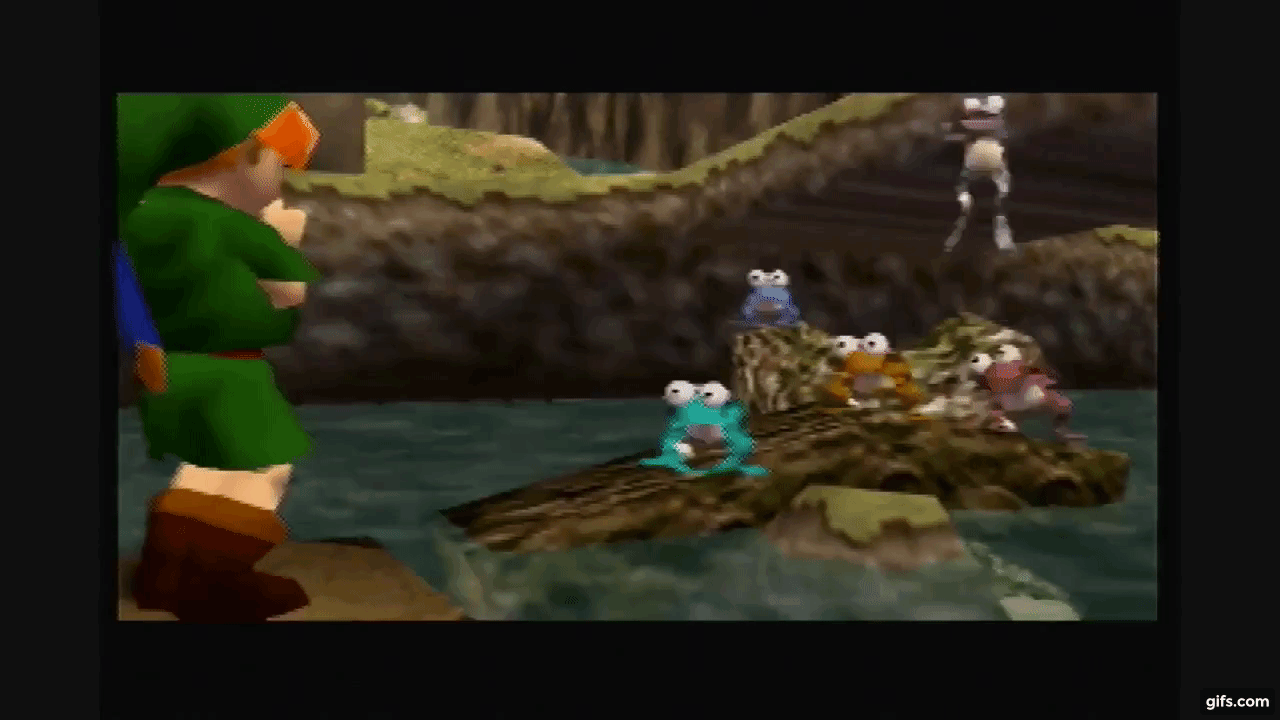
Link (Koji Kondo) playing game music for obsessed and emotionally compromised fans (like me). The fact that Link collects a rupee afterwards makes the metaphor all the more fitting.
Now for the specifics. Game music is different from other sense data because it triggers a unique kind of autobiographical memory. For Proust’s narrator, the taste of a petite madeleine reminds him of a time in the past when he experienced that same sense input—when he ate a petite madeleine as a child. The cookie’s taste directly connects the narrator “now” with the narrator “then.” This kind of autobiographical memory is unidimensional: it uses the same sense input to connect the same person through different points in time.
Game music, on the other hand, triggers a multidimensional autobiographical memory. It adds another phenomenological layer to the madeleine effect—the phenomenological layer of the avatar. Rather than simply connecting the gamer listening to the music in the present with the same gamer listening to the same music in the past, this kind of memory superimposes the gamer’s experience playing the game onto the avatar’s experience living the game. The music brings us back to a mixed memory, one that melds our personal past as the player in front of the screen with our vicarious “past” as the avatar in the game. The upshot is that when game music sweeps us back in time, the memory we enter into isn’t purely our own. It’s shot through with the “memory” of the avatar, making each experience color the other.
Since I’m a literary nerd, I picture this phenomenon working like a palimpsest. A palimpsest is a type of manuscript that arose in Western European monasteries during the 5th and 6th centuries CE. Since writing material was scarce, monks would erase the text written on a sheet of animal hide and re-use the same sheet to write out new text. Over time, the layers of erased words would reappear underneath the newer layers, creating overlays of multiple, faintly-discernible manuscripts. Replace the layers of text with layers of experiences—my experience listening to Zelda music now, my experience playing Zelda then, Link’s “experience” within the game and outside my own timeline—and you have a palimpsest of video game phenomenology.
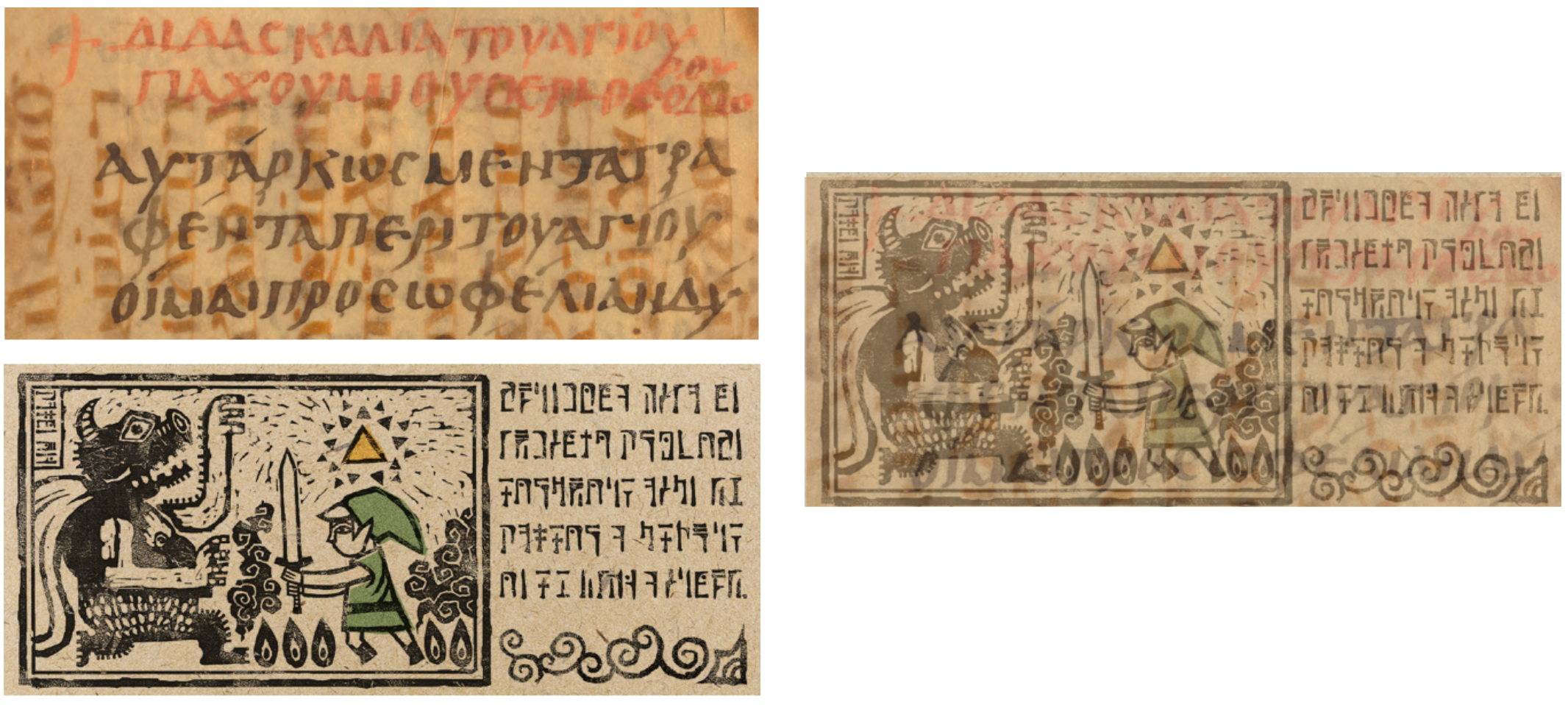
A typical palimpsest from the Dark Ages (think “madeleine effect”), superimposed on an “ancient” manuscript from The Wind Waker. The hybrid illustrates the kind of multidimensional autobiographical memory triggered by game music.
In action, this phenomenon looks exactly like what happens to me when I hear The Wind Waker title theme, not just in the drama-filled setting of The Symphony of the Goddesses. At the first pluck of the strings, I’m not just transported back to my own childhood. I’m transported back to Link’s childhood, too. I feel whisked away by almost sickening nostalgia for a simpler time, before I had to move away from home, sail treacherous seas, go to college, save Hyrule. Like the petite madeleine, the music pulls me back into the past, but unlike the episode in Proust’s novel, these memories have melded with the memories of another person—the avatar. The longing isn’t just for the Saturday afternoons sitting on the living room floor, playing Zelda. It’s for the sunny afternoons romping around Outset Island, throwing pigs and jumping on rocks. It somehow feels as if I shared Link’s innocence before he became the hero—just as The Wind Waker shared my own innocence before I became an “adult.” The music superimposes the avatar’s memories on my own, and I’m left feeling nostalgic for something that doesn’t exist. The Wind Waker’s title theme makes a palimpsest of phenomenological experiences.
For lack of a more creative alternative, we’ll call this phenomenon the Outset Island effect.
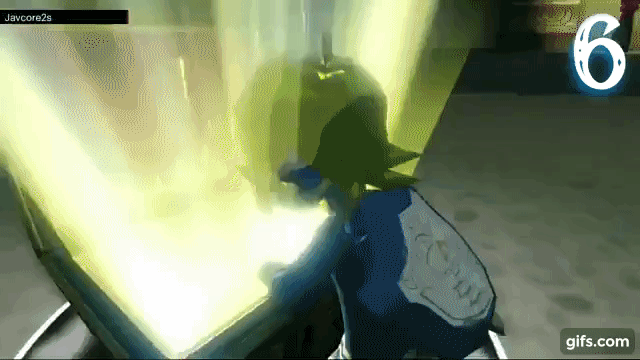
When the author of a think-piece finally gets to the point.
This effect, of course, isn’t so broad that it kicks in every time we hear a snatch of game music. The madeleine effect, after all, didn’t hit Proust’s narrator every time he ate a cookie. But neither is the effect so narrow that it strikes only those gamers whose experiences playing the game match perfectly with the avatar’s experiences living the game, as my childhood aligns uncannily well with Link’s childhood in The Wind Waker.
The question, then, is simple: what makes the Outset Island effect tick?
Factor 1: Overlapping Emotions
As I see it, three factors are at work behind this phenomenon. The first I’ll call a necessary condition; the last two I’ll call intensifying features. I’ll use my experiences with The Legend of Zelda to take each one in turn.

Video-game theory: a philosophical fetch-quest of the first degree.
The first element, the necessary condition that must be present for the Outset Island effect to work, is shared emotional experience between the gamer and the avatar. Whenever we undergo some emotionally charged moment in a game, chances are that we’re going to feel some kind of Outset Island effect when the tune marking those moments plays, even if the avatar’s experiences within the game don’t align perfectly with our experiences outside the game.
Let’s take the example of the Darknut mini-boss, the fierce iron-plated beast-knight Link battles in a number of Wind Waker dungeons. I, for one, have never fought anything worse than a cold, much less a sword-slashing monster, in my life. Why do my palms start to sweat when I hear the threatening mini-boss theme?

Sends chills down the spine.
Even if I’ve never picked up a sword, Link and I still share the same battle experience. For Link, it’s a hand-to-hand fight that ends in virtual life or virtual death. For me, it’s a joystick-to-pixel challenge that ends in a hearty fist-pump or a GameCube controller slamming against the wall. (Never underestimate the emotional trauma induced by Game Over screens.) When the dungeon door locks behind Link, my heart rate quickens. When the mini-boss disappears in a puff of purple smoke, I breathe a sigh of relief, just as I would if I were actually Link fighting a real monster. Because I identify with the avatar as I play, I experience the emotions in real life that I would experience if I were actually in the game. A stressful experience for Link is a stressful experience for me.
Granted, the stress levels might be different (I certainly hope Link gets more stressed facing the Darknut “in person” than I get facing the Darknut through a screen), but after the battle, Link and I have still both undergone a stressful experience. The degree of stress we feel is different, but we still share a stressful battle “memory.” As a result, when the boss theme plays, I’m transported back to both a sweaty joystick and a pixelated sword. I feel nervous as both the player and the avatar. Our mutual experience overlaps.
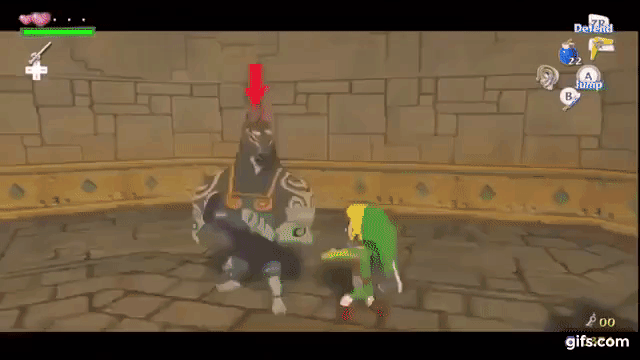
A puff of purple smoke and instant relief. Does Link even vape, bro?
But emotionally-charged events shared by gamer and avatar aren’t limited to sweat-inducing battle sequences. Why does Zelda’s lullaby tug at our heartstrings whenever it plays? Because we’ve spent just as much effort as Link has to rescue her from Ganondorf! We may not have lost hearts, downed potions, upgraded weapons, and talked to oddball strangers in green tights, but we’ve certainly lost sleep, downed caffeine, updated gaming systems, and chatted with oddball strangers in cheat forums online as part of the same quest. We want to save Zelda just as much as the Hero of Time does. And even if she’ll never be the Triforce-bearing soulmate for us that she is for Link, we still feel a soft spot for this beloved princess whom we’ve spent so much time and energy trying to rescue. That spot gets poked, with oddly profound poignancy, whenever we hear her lullaby.

Sniff.
The same idea applies to the fanfare from The Wind Waker end-credits scene. Those triumphant horns blast with the whooshing wind, and Link sails off into the sunset just before the screen fades to black. Link bids farewell to Outset Island the moment we say goodbye to The Wind Waker. After hours of sweaty palms, obscure puzzles, and stressful mini-boss battles, both avatar and player have set Hyrule aright again. We take one last look at the experiences behind us—Link’s comforting memories of home and our enjoyable memories of the game—and we leave those experiences behind, venturing out into a different (and in our case, “real”) world. We get pulled back into that leave-taking moment every time the bittersweet fanfare sounds.

Link, having defeated Ganondorf, finds it impossible to return to the Shire and strikes out West in search of more adventure.
The Outset Island effect size is certainly larger the more precisely the avatar’s reality overlaps with our own reality (e.g., my memories of The Wind Waker’s title theme), but we still feel an inkling of the phenomenon whenever game music recalls an experience that aligns our emotional investments with those of the avatar (e.g., mini-boss battles, Zelda encounters, leaving Outset Island).
Factors 2 and 3: Specificity and Sourceless Sound
If this is the case, we’re left with a pressing question: what makes the Outset Island effect special? What’s to keep it from being just a vague feeling we get whenever we hear game music, instead of an unmistakably powerful jump into a memory that overlaps our phenomenology with that of the avatar? The answer lies in the two intensifying factors I mentioned earlier: game music’s specificity and its non-diegetic character. These two features, building on top of emotional alignment, make the Outset Island effect more a Proustian experience than an unfocused feeling.

More fetch-questing.
To take on the first, specificity is the degree to which particular game music is directly associated with particular game experiences. Specificity is Koji Kondo’s signature. Practically every place, character, and narrative event in The Legend of Zelda series has its own unmistakable tune: the Hylian seas’ rollicking theme, Dragon Roost Island’s airy pipes, the pirate ship’s boozy brass, Grandma’s nostalgic melody, Beetle’s nutty drum-knocks, the boss-battle victory fanfare. Venturing outside The Wind Waker, the examples only get more iconic: the whistling Lost Woods, sleepy Lon-Lon Ranch, pounding Hyrule Field. (And of course, the puzzle-solving chime that gives every Zelda player a high.)
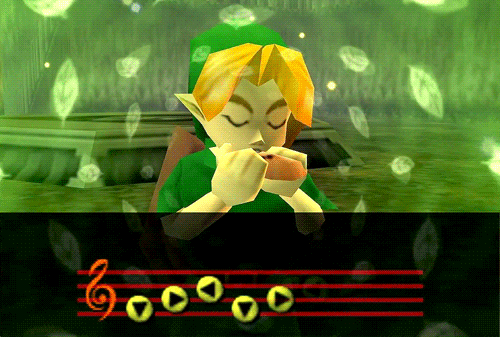
Just try not humming.
We only hear these signature tunes when we encounter the specific place, character, or experience that they identify. We hear the rumbling Gerudo Valley theme only when we’re actually adventuring through the desert, the enemy face-off score only when we’re about to obliterate an evil minion for goodies, the treasure-chest flourish only when we’ve uncovered some new item. And because Koji Kondo’s genius makes the character of the music fit so perfectly with the particular game element it describes, we have a hard time dissociating one from the other. Just try to imagine the sun rising in a Zelda game without the soprano trill, or the Great Fairy Fountain without the floating scales. Difficult, isn’t it? We hear The Wind Waker’s title theme, and it’s almost impossible to imagine anything but the rolling shot of Outset Island, to feel anything but the thrill that we shared with Link at the outset of another adventure. Because this connection is so hyper-focused, hearing the music shoots us back into the corresponding game element with uniquely vivid intensity.

Cue the chorus.
The second intensifying factor is game music’s non-diegetic character, which makes the flashback into a multilayered past—based on emotional alignment and streamlined by specificity—especially engrossing. “Non-diegetic” means that the music we hear while playing the game doesn’t come from a present or implied source within the game. There isn’t a philharmonic orchestra bouncing beside Epona whenever Link takes off across Hyrule Field, but like a movie score, the Hyrule Field theme still manages to play through the pixelated ether.
The final battle in Ocarina of Time nicely illustrates the difference between diegetic and non-diegetic sound.
- Diegetic: Link walks into the tower, we hear creepy organ music, and we see Ganondorf playing a creepy organ.
- Non-diegetic: the battle begins, we hear the boss battle theme, and we don’t see an orchestra, nor do we have any reason to suspect that Koji Kondo and crew are hiding behind the curtains.
It’s true that a good bit of Zelda music is diegetic (it’s hard to imagine playing The Wind Waker or Ocarina of Time without playing the Wind Waker or the Ocarina of Time), but most run-ins with characters, dungeons, battles, places, and puzzles—the majority of game experiences that trigger the Outset Island effect—happen to the tune of non-diegetic sound.
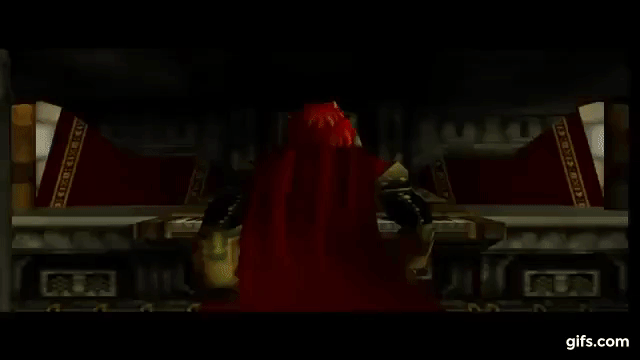
Ganondorf: maestro of diegetic creepiness.
Because the specific sound that marks these experiences is non-diegetic, there isn’t a source of music to mediate between the tune we hear and the experience we associate with that tune. As a result, we come to think of the experience itself as the source of the music. There isn’t a big brass band that materializes whenever the Darknut mini-boss appears, or a mariachi band that waits on the other side of the bridge in the Gerudo Desert, or a harpist that follows Princess Zelda when she walks around Hyrule Castle. Battles just make that stress-inducing theme; Gerudo Valley just sounds like a maraca party; the lullaby is simply a part of Princess Zelda. With no source standing in between, the music and the experience completely intermesh.
As a result, with non-diegetic music, we don’t experience the phenomenal sequence: walking around Outset Island, seeing philharmonic orchestra, hearing Outset Island theme. We experience a sequence much closer to: walking around Outset Island, hearing Outset Island theme. The music maps directly onto the experience, so that, when the Outset Island theme kicks in, the experience maps directly onto the music.
As a consequence, we can easily reverse the sequence when we’re not playing the game. We can hear the title theme while we’re sitting on the subway, and we don’t have to see a violinist on the other side of the train to suddenly feel like we’re sitting on the shore of an island in the middle of the Hylian seas—nor, perhaps more importantly, do we have to imagine a violinist inside the mixed memory before we feel like we’re really reliving the game.

Me, running to the grocery store with headphones on.
Take the avatar’s point of view. How realistic would it be to have an orchestra arranged on Outset Island beach, merrily strumming away while we chased pigs around the village? That would feel fake—like we were a character in a video game, instead of a hero saving a real virtual world. The non-diegetic character of the music preserves the authenticity of the simulation. If we’re talking about reliving the avatar’s game experiences in a way that feels engrossingly real, it’s crucial that the music not have an obvious source within the game. Such a source would stick out like a sore thumb, only taking away from the totalizing effect of the mixed memory.[2]
The Upshot: A Link Between Worlds
This last point about non-diegetic sound takes us to a charming paradox. Game music should generally be non-diegetic if we’re to preserve some element of realism within the game—that is, if the avatar’s experience is going to feel real when we flash back into a mixed memory of that experience via the Outset Island effect. But at the same time, the music itself should alert us to the artificiality of the experience we’re zooming back into. If we were really a green-garbed Hero of Time galloping across Hyrule Field with rupees in our pocket and the Master Sword at our hip, we wouldn’t hear any music. If we could grab Link by his tunic collar and yank him into this dimension, he would, presumably, have no idea what Koji Kondo’s scores sound like. Real battles, real princesses, and real valleys don’t sound like symphonies. The non-diegetic music, as a result, alerts us to the fact that we’re enjoying a kind of augmented experience—that we’re enjoying something much closer to art than to real life.

Link and Epona, cantering across Hyrule Field to the sound of chomping carrots.
But what would make an experience artificial for the avatar within the game makes that same experience authentic for the gamers outside Hyrule. Link may not hear the Outset Island theme, but we do. And for the reasons explored above—emotional alignment, specificity, and non-diegetic character—that music is a critical feature of our experienced reality living Link’s experienced reality. It’s a feature of the game that moves across and between the different layers of our phenomenal memory. We hear Zelda’s lullaby when we’re Link standing outside Hyrule Castle and when we’re the gamer sitting in front of the screen. But because the lullaby is designed for us and not for Link—because it’s an artificial augmentation of the game-reality, reaching from our dimension into Link’s—it doesn’t stay trapped in the world of the avatar. We can hear the same lullaby when we’re standing outside CVS, listening to Kondo’s soundtracks through our headphones. And suddenly, the emotionally-charged, specific, non-diegetic lullaby turns CVS into Hyrule castle. The music is the interdimensional link between all three layers of experience. It’s the thread tying the phenomenological palimpsest together.

The Legend of Zelda soundtrack: a link between worlds.
There are many questions left unanswered about the Outset Island effect as a theory. How does the effect change across different sense-inputs? What happens if a sense-input evokes emotional dissonance between the avatar and the player, instead of emotional alignment? How does the effect change with the changing life-experiences of the gamer? But the upshot of this phenomenon—what happens when the theory meets the recalcitrant stuff of life—is that the Outset Island effect brings new meaning to our present experiences in the world outside Hyrule. By connecting us, via mixed memories, across our own diverse phenomenal layers, the music colors our current reality with both a real and a vicarious history. The music helps us interpret the present in light of a portable past.
Say, for instance, that I’m about to graduate college, and I listen to the fanfare in the final scene of The Wind Waker. I imagine myself walking off the stage with my diploma, and suddenly, I’m casting off Outset Island, a triumphant hero sailing into new adventures. Say I’m on my way to an interview, and I listen to the Darknut mini-boss battle music. My hands start sweating, I feel a pump of adrenaline, and suddenly I’m Link gripping a sword, ready to slay this challenge. Say I’m walking through a new city, and I play The Wind Waker title theme through my headphones. All at once, I’m back in childhood, back in the living room playing Zelda with my sister, and suddenly, I start to feel like Link romping around Outset Island. Suddenly, this strange place feels a bit more like home. I start to feel like something of a twenty-first century Hero of Time, and my own life, even just for a moment, feels like an adventure.
- Proust, Marcel, D. J. Enright, C. K. Scott-Moncrieff, and Terence. Kilmartin. In Search of Lost Time. Modern Library Paperback ed. New York: Modern Library, 2003, 60, 63-4. ↑
- The obvious exceptions to this claim are game experiences that involve actual sources of music, in which case, the sound had better be diegetic if the experience is going to seem real from the avatar’s point of view. When Link walks into Ganondorf’s tower at the end of Ocarina of Time, for instance, it takes nothing away from the authenticity of the scene that we see a creepy organ when the creepy organ music plays. The organ is part of the avatar’s lived experience; in this case, the diegetic character of the music actually makes the experience more realistic. ↑




1 Comment
Caymus Ducharme · September 25, 2020 at 10:45 pm
What a fantastic article, Lauren! I have spent years trying to articulate how music in video games moves beyond the simplicity of generating emotion, and you have done just that. When I listen to the soundtrack of one of my favorite movies, I experience the music for what it is, maybe recalling an impactful moment when it played, but when I listen to the soundtrack of one of my favorite games, it does so much more—it propels me back to my first time playing the game and allows me to relive it. Even as I write this comment, I am listening to “When My Mother Was There” from the OST of Persona 5, and I can’t help but feel like I am looting the palace it plays in all over again. And I did that just a week ago!
One of the aspects that I think goes unnoticed when talking about video game music is the use of frequency. Most video game music plays on repeat—battle and field themes, for instance. The remaining tracks are usually saved for specific, memorable scenes, such as final boss themes. This dichotomy works specifically to make video game music more impactful.
With repetitive tracks, the game causes the player to associate that music with the area they are in and the actions they are doing by exposing them to it for prolonged periods of time. From this association, the Outset Island Effect arises. When the player hears music that they associate with a specific area, it evokes the memories not only of that area but also of what the player did there, which allows the player to not just recall but also relive their experience. Because video games are inherently interactive, the associations that video game music creates also involve actions, making the Outset Island Effect so unique.
On the other side, the non-repetitive tracks become equally as impactful as a result of the repetitive tracks. Because most of the music plays on repeat for long periods of time, the tracks that don’t do so leave a major impact. When the player is so used to hearing the same music over and over, they more readily notice when a special track appears, making those moments much more impactful. I mean, seriously, who didn’t lose their mind when “One-Winged Angel” started playing in FF7’s final battle? That moment stands out because the music is only used in that one instance, making it all the more memorable. (It might also have something to do with the fact that the song is an absolute banger, but that’s beside the point.)
Video games brilliantly merge these two techniques, and it makes their music significantly more memorable. I can only remember a select few tracks from the OST of my favorite movie, A Silent Voice, but if you ask me about the OST of my favorite game, Xenoblade Chronicles, I can practically identify each of its 100+ tracks, the locations they play in, what happens in the story at that point, and so on. Video game soundtracks capitalize on human psychology to excellent effect, and I find that absolutely fascinating!
If you’re interested in similar takes on the subject, I would definitely recommend Daryl Talks Games’s video titled, “How Music Encodes Your Memories | Psych of Play,” since it discusses video game music and memory from more of a psychological perspective. Although what he is talking about does noticeably differ from the Outset Island Effect, it is still a great thought piece about music in video games.
Once again, thanks for the great article. I look forward to reading more from you in the future. Welcome to the site!